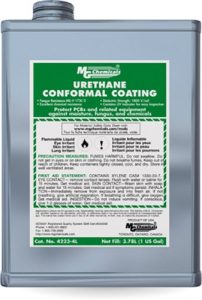Silicone vs. Urethane Conformal Coating
Posted by Sean Horn
Friday, October 12, 2012 11:07
@ 11:07 AM
Silicone and urethane are two of the most popular conformal coating types. They are widely used for a variety of their properties, but which is a better coating? While this ultimately depends on your application, let’s take a look at some of the pros and cons of each.
Silicone Conformal Coating
Benefits
![]() Most typical silicone coatings have continuous operating temperature ratings of 200ºC. This is far higher than most urethanes (125ºC). Some silicone coatings are rated as high as 600ºC for ultra-high temperature applications. We have seen a great deal of use for silicones in the automotive industry, where temperatures can get upwards of 175ºC in the engine compartment.
Most typical silicone coatings have continuous operating temperature ratings of 200ºC. This is far higher than most urethanes (125ºC). Some silicone coatings are rated as high as 600ºC for ultra-high temperature applications. We have seen a great deal of use for silicones in the automotive industry, where temperatures can get upwards of 175ºC in the engine compartment.
An additional benefit of silicone conformal coating is its excellent moisture protection. Silicones have been used in cases where there were extreme temperature differences, which resulted in excessive moisture. Other conformal coatings failed within hours or days, while silicone, especially when applied thickly, has been proven to succeed. One particular application was for electronically controlled heaters developed for artic temperatures. The heaters would warm to almost 150°F, then cool to ambient temperature, sometimes as cool as -40°F. This wide temperature swing would happen very quickly, resulting in a high moisture environment. Other coatings, such as urethanes, resulted in board failures but silicones ended up being the only proven alternative.
Silicone conformal coatings are also among the easiest to apply and re-work. Silicone coatings are typically low on solvents, ensuring a smooth coat that cures very quickly (about one hour at room temperature). Silicones are quite flexible and soft, having a relatively weak resistance to solvents. For assemblies that will require work after coating, this is critical because it will keep labor time down without compromising the integrity of the coating.
When not to use
Silicone conformal coatings are required to be applied thicker than other conformal coatings. The target thickness is between 0.00197” to 0.00827”. It would be wise to seek other coating options if your application has tight clearance tolerances or if the solder joints cannot support the stresses placed upon it by the thicker layer of coating.
Types of Silicone Conformal Coating
- Humiseal 1C49
- HumiSeal 1C49LV
- HumiSeal 1C51
- HumiSeal 1C55
- Dow Corning 1-2577
- Dow Corning 3-1753
- Dow Corning 3-1765
- Dow Corning 3-1744
- Dow Corning 3-1953
- Dow Corning 3-1965
- Dow Corning 3-1944
- MG Chemicals 422B
- Peters DSL 1705 FLZ
- Peters DSL 1706 FLZ
- Electrolube SCC3
- Electrolube SCC4
Urethane Conformal Coating
Benefits
 Type UR conformal coatings are very resistant to chemical solvents. They are second only to parylene conformal coating in their resistance. Applications that require any prolonged exposure to harsh chemical solvents should consider urethane resins.
Type UR conformal coatings are very resistant to chemical solvents. They are second only to parylene conformal coating in their resistance. Applications that require any prolonged exposure to harsh chemical solvents should consider urethane resins.
Long term NASA studies have shown that urethane conformal coatings are one of the few ways to successfully mitigate tin whisker growth. Since there is no known way to completely eliminate tin whisker growth, you have to select a proper tin whisker mitigation strategy. Urethane conformal coatings are a great place to start.
For applications that can see any direct mechanical wear against the coating should consider urethane conformal coatings. Urethane resins are very hard and resistant to mechanical wear. Their hardness is second only to epoxy conformal coating, but urethanes are much easier to be reworked than an epoxy.
When not to use
For products going into a high vibration environment, urethane conformal coatings are not a good choice. Because of the mechanical strength and resistance to abrasion characteristics that urethanes typically exhibit, a high vibration environment could ultimately end up weakening the integrity of this rigid coating. A better choice for a high vibration environment would be to go with a completely conforming, flexible coating, such as parylene conformal coating.
If an application is going to a high heat environment, urethanes will not provide the protection that is required. Leading urethanes, such as HumiSeal 1A33, offer protection to 125ºC. Silicone conformal coatings, on the other hand, offer protection of 200ºC or higher. This is typical with conformal coatings, as silicones typically offer the best protection, temperature wise.
Types of Urethane Conformal Coating
- HumiSeal 1A33
- HumiSeal 1A20
- Humiseal 1A27
- Humiseal 2A64
- HumiSeal 1A34
- Hysol PC18M
- CONATHANE CE-1155-35
- CONAP CE-1170
- CONATHANE CE-1164
- Techspray Fine-L-Kote
- MG Chemicals 4223
- Electrolube PUC
Conclusion
There are many benefits to using either a silicone or urethane conformal coating. Certainly either coating is better than none, but the trick is to align your products potential issues with the strengths of the conformal coating that can best protect it. If there is some doubt to which coating is best, it may be worth it to have an outside party provide consultation services for your application.
Diamond-MT offers both silicone and urethane coating services as well as conformal coating consulting. Our team of experts is committed to providing the high-quality service your project needs. To learn more about our services, contact us at 1-814-535-3505 or request a quote.
Comments
Homepage 4/17/2020. 10:17:10 AM
... [Trackback] [...] Informations on that Topic: blog.paryleneconformalcoating.com/whats-the-difference-between-potting-and-conformal-coating/ [...]

londondrugscanada.bigcartel.comlondon-drugs 4/17/2020. 10:17:10 AM
cialis uk https://londondrugscanada.bigcartel.com/london-drugs This is nicely expressed. !